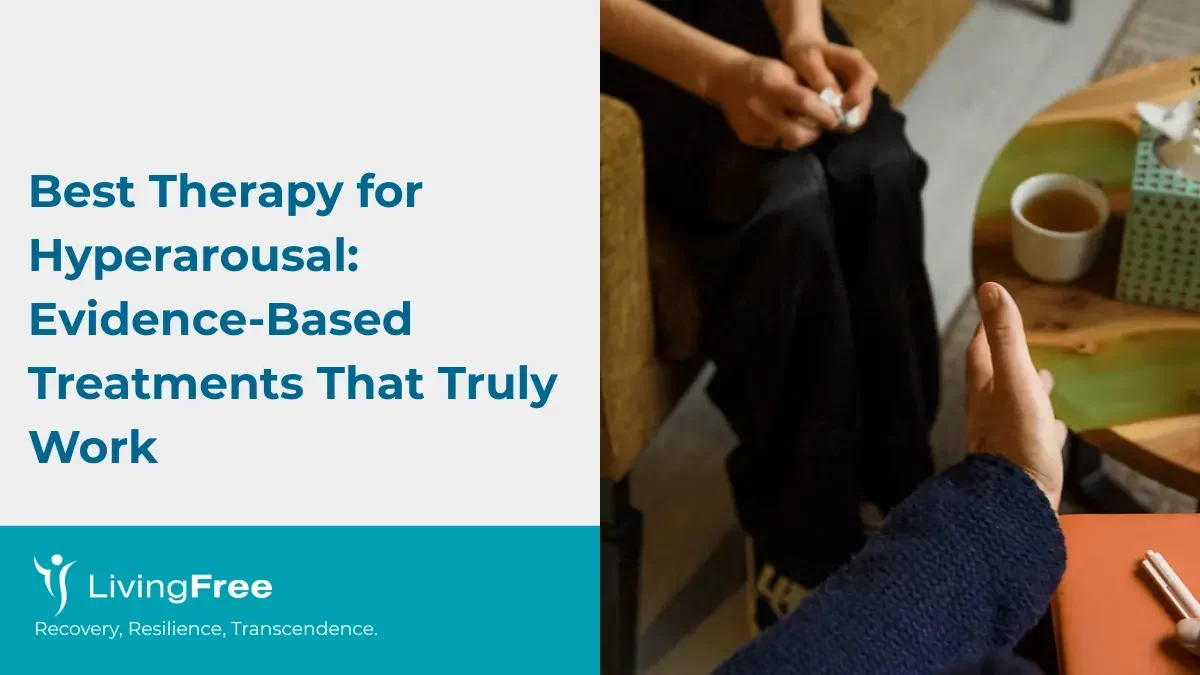Hyperarousal is one of the most disruptive symptoms of chronic stress and trauma. It shows up as a constant feeling of being “on edge,” difficulty sleeping, irritability, and an exaggerated startle response. Fortunately, there are several evidence-based therapies for the best therapy for hyperarousal and help the nervous system return to safety.
What Is Hyperarousal?
Hyperarousal is a state of heightened physiological activation caused by an overactive sympathetic nervous system. It often appears in PTSD, anxiety disorders, and prolonged stress exposure.
Common symptoms include:
- Difficulty falling or staying asleep
- Feeling jumpy or easily startled
- Irritability or anger outbursts
- Constant vigilance / scanning for danger
- Difficulty concentrating
- Increased heart rate and muscle tension
While occasional hyperarousal is normal (e.g., after a stressful event), persistent hyperarousal requires focused treatment.
Best Therapies for Hyperarousal
1. Trauma-Focused Cognitive Behavioral Therapy (TF-CBT) & Prolonged Exposure (PE)
- Best for: PTSD-related hyperarousal, trauma survivors
- Core benefit: Helps the brain reprocess traumatic memories so the body no longer overreacts to reminders.
- What it targets: Avoidance, intrusive memories, and fear-based hyperreactivity.
Guidelines consistently rank trauma-focused psychotherapy as first-line treatment for trauma-related hyperarousal.
2. Eye Movement Desensitization and Reprocessing (EMDR)
- Best for: People who struggle to verbalize trauma or feel overwhelmed by traditional talk therapy.
- Core benefit: Reduces the emotional charge of traumatic memories, which lowers physiological arousal.
- Evidence: Shown to be as effective as CBT for many PTSD symptoms, including hyperarousal.
3. Exposure Therapies (Situational, Imaginal, Interoceptive)
- Best for: Trauma, phobias, panic disorder.
- Core benefit: Gradually retrains the body to stop responding with alarm.
- Why it works: Avoidance keeps the nervous system in “danger mode.” Exposure reduces this cycle.
4. DBT Skills + Mindfulness-Based Approaches
DBT modules helpful for hyperarousal:
- Distress tolerance
- Emotion regulation
- Grounding techniques
- Mindfulness practices
These skills offer immediate, practical tools to reduce physiological arousal—especially useful between therapy sessions.
5. Sleep-Focused Therapies (CBT-I, Imagery Rehearsal Therapy)
Because poor sleep increases daytime arousal, treating sleep often reduces hyperarousal more than people expect.
CBT-I helps with:
- Sleep inconsistency
- Nighttime hypervigilance
- Racing thoughts at night
IRT helps with:
- Recurring nightmares.
- Trauma-related sleep disturbances.
6. Medication (SSRIs, SNRIs, Prazosin for Nightmares)
Medication is not always required, but it can be life-changing for:
- Severe hyperarousal.
- Co-occurring anxiety or depression.
- Sleep disturbance that therapy alone cannot manage.
Common options include:
- SSRIs/SNRIs for general PTSD/anxiety symptom reduction
- Prazosin for trauma-related nightmares
- Short-term anxiolytics (used cautiously)
7. Complementary / Emerging Approaches
These are helpful adjuncts but not typically standalone front-line treatments:
- Neurofeedback
- rtfMRI Neurofeedback
- Psychosensory techniques (Havening, EFT tapping)
- Somatic therapies (sensorimotor psychotherapy, SE)
- Yoga-based or breath-based interventions
Evidence varies, but many people report symptom relief when combined with structured therapy.
Additional Self-Regulation Tools to Support Therapy
These techniques reduce sympathetic arousal and improve nervous-system recovery between sessions:
- Diaphragmatic breathing
Slows heart rate and shifts the body toward the parasympathetic state.
- Temperature grounding (e.g., ice, cold water on wrists)
Interrupts panic signals and lowers physiological activation.
- Progressive muscle relaxation
Releases trauma-related or stress-related muscular tension.
- Gentle movement (walking, stretching, yoga)
Helps the body discharge stress and stabilize the nervous system.
- Sleep hygiene routines
Better sleep = significantly lower daytime hyperarousal.
When Hyperarousal Becomes a Problem: “Treatment Thresholds”
Hyperarousal isn’t always pathological, but there are clear limits where it becomes a clinical concern and professional treatment is recommended.
You should seek professional help if:
1. Symptoms last longer than 4 weeks
Especially after a traumatic event or major stressor.
2. Hyperarousal interferes with daily functioning
Examples:
- You can’t focus at work
- Your sleep is severely disrupted
- You avoid social situations due to being “on edge”
- Irritability affects relationships
3. You experience repeated shutdowns or panic-like episodes
These are signs the nervous system is stuck in a dysregulated loop.
4. You have trauma memories or triggers that cause intense reactions
Even if the trigger seems “small” or unexpected.
5. You can’t calm down even with grounding or coping tools
This suggests the hyperarousal is no longer manageable through lifestyle strategies alone.
6. You have intrusive thoughts, dissociation, or emotional numbness alongside hyperarousal
These are indicators of PTSD or trauma-related conditions.
7. Your body is constantly activated
If your baseline feels like:
- Heart pounding
- Shoulders tensed
- Jaw clenched
- Startling at everyday sounds
Then therapy, especially trauma-informed therapy is recommended.
Frequently Ask Question (FAQ) of Hyperarousal.
1. What is the most effective therapy for hyperarousal?
Trauma-focused therapies—such as EMDR, TF-CBT, and Prolonged Exposure—are considered the most effective, especially when hyperarousal stems from trauma.
2. Can hyperarousal go away on its own?
Mild hyperarousal may lessen, but persistent symptoms lasting more than 4 weeks usually require professional treatment.
3. How do you calm hyperarousal quickly?
Breathing exercises, grounding (like cold water or ice), progressive muscle relaxation, and gentle movement can reduce symptoms in minutes.
4. When should I seek therapy for hyperarousal?
If symptoms disrupt daily life, last more than a month, or cause sleep issues, irritability, panic episodes, or difficulty functioning, therapy is recommended.
5. Do medications help with hyperarousal?
Yes. SSRIs/SNRIs can reduce overall symptoms, and prazosin is often used for trauma-related nightmares. Medication is usually combined with therapy.
6. What happens if hyperarousal is left untreated?
It can lead to chronic insomnia, panic episodes, emotional regulation problems, or worsening PTSD or anxiety symptoms over time.
7. Is hyperarousal always caused by trauma?
Not always. It can also come from anxiety disorders, chronic stress, nervous system dysregulation, and sleep deprivation.
Final Thought
Hyperarousal is challenging, but you don’t have to navigate it alone. Daily habits and therapy can bring real relief, and if your symptoms feel constant, overwhelming, or begin disrupting your sleep, work, or relationships, it may be time to reach out for support. When you’re ready, contact us. We’re here to listen and help you find steadiness again.
Related Reading:


